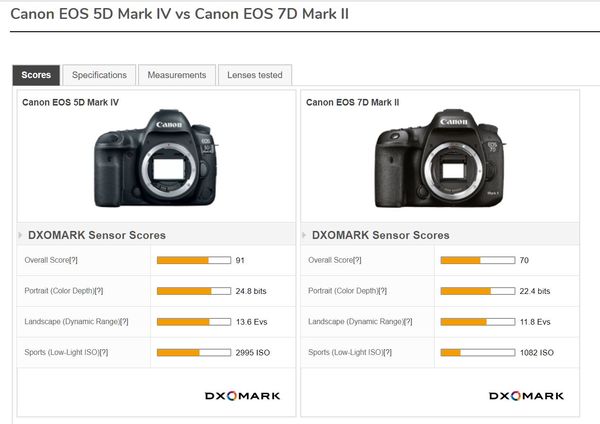Canon 5D IV for sports
Jun 9, 2020 11:46:30 #
Boosesb wrote:
Has anyone used the 5dIV For sports photography? I have a 7dII with 100-400II lens. B&H has the 5d on sale for $1999 andt.
---------------------------------------------------------------------
BTW, BooSesb
If you want a lower price on the 5D Mk IV... Look at the below .... PRICE $ 1,749.99
Above is 'Band New' from Authorized Dealer w/ USA warranty and free shipping.... NOW, that is a good deal
https://www.cpricewatch.com/product/06120/Canon-EOS-5D-Mark-IV-price.html
Cheers
GeoVz
------------------
Jun 9, 2020 12:11:29 #
Successful photographers do the one thing the unsuccessful are unwilling to do: they buy a full-frame camera.
Jun 9, 2020 12:18:35 #
CHG_CANON wrote:
\\Successful photographers do the one thing the unsuccessful are unwilling to do: they buy a full-frame camera.
====================================
Canon... I full agree with you... and would like to put a small twist to it.....
Put another way..... Many, Many photographers fail to see the importance of a full frame camera
Cheers
GeoVz
...
Jun 9, 2020 12:33:49 #
I converted to 5d Mark iv's last summer. I shoot equine events (cutting, sorting, barrel racing, etc) and high school sports for a weekly newspaper. The cameras haven't missed a beat. I haven't noticed that the slower fps has had any effect on what I'm able to capture. I traded a 7d Mark ii and an 80d for my 5d's. I don't think you'll go wrong with the move up to full frame.
Jun 9, 2020 12:59:11 #
Absolutely correct: I have stated this in the past here on UHH. I do shoot a Canon 7D camera but I don’t use EF-s lens at all. I use EF L FF lens on the 7D the center is at its sharpest focal point on the smaller sensor. The view of 50mm lens is the same on a smaller sensor it’s all in the FOV it’s just limited by size, the larger sensor will capture more surface area with same lens.
goldstar46 wrote:
--------------------------------------------------... (show quote)
Jun 9, 2020 14:09:09 #
goldstar46 wrote:
--------------------------------------------------... (show quote)
Your opinion, not facts
Jun 9, 2020 14:19:54 #
PHRubin wrote:
Your opinion, not facts
-------------------------
Paul,,, With all due respect, do you own research.... What I have written is 'fact' and NOT opinion...
You are exposing you 'lack of knowledge' on the subject...
... and that's OK if you wish to 'stay in the dark and remain uninformed... '
..... You have the right to do that.
Cheers
GeoVz
-----------------------------------
Jun 9, 2020 14:53:17 #
goldstar46 wrote:
-------------------------
Paul,,, With all due respect, do you own research.... What I have written is 'fact' and NOT opinion...
You are exposing you 'lack of knowledge' on the subject...
... and that's OK if you wish to 'stay in the dark and remain uninformed... '
..... You have the right to do that.
Cheers
GeoVz
-----------------------------------
Paul,,, With all due respect, do you own research.... What I have written is 'fact' and NOT opinion...
You are exposing you 'lack of knowledge' on the subject...
... and that's OK if you wish to 'stay in the dark and remain uninformed... '
..... You have the right to do that.
Cheers
GeoVz
-----------------------------------
I particularly take issue with the angle of view statement. It is totally irrelevant what AOV a lens has outside a camera. The AOV captured by the sensor is what is important to the photo and, hence, the photographer. If I have two cameras of the same MP, one FF, one crop, for any given lens f/l the crop camera, in the photo, will put more pixels on the subject. That is more reach and shallower AOV, as far as the product, and therefore, the photographer is concerned.
It really boils down to how you express it.
Jun 9, 2020 16:35:07 #
Jun 9, 2020 17:35:00 #
amfoto1
Loc: San Jose, Calif. USA
goldstar46 wrote:
br br b There is no such thing as an 'Advantage... (show quote)
I don't agree.
First of all, the image area of a full frame camera's sensor is 864 square millimeters. The image area of a Canon APS-C sensor is 332mm sq. What this means is that the APS-C sensor is 38.4% the size of the FF sensor. Or, it's "61.6% smaller" (not "40% smaller").
However, for telephoto work, the APS-C camera is often superior. I proved it to myself years ago, with direct comparisons. We took test shots of the same subject at the same distance with the same L-series EF lens on an APS-C 7D (18MP) and on a full frame 5D Mark II (21MP). Then we cropped the full frame image down to match the crop camera's image exactly. It was apparent to everyone that the APS-C camera's image was superior (despite the fact that the 7D has a fairly strong anti-alias filter, while the 5DII has a weak one).
The reason for this is pretty simple. After the crop, the 5DII's remaining image was around 8MP. In comparison, the image from the 7D was 18MP.
Unless a full frame camera has a ton of resolution, this will always be the case. Today's 7D Mark II is 20MP. Today's 5D Mark IV is 30MP, but if you crop it's images down to match a 7DII's, you're only left with about 11.5MP.
Sure, you can fit a longer telephoto to the full frame camera, to be able to use the entire sensor and get all its "goodness". But then you're getting into big, heavy, expensive lenses. For example, I've done a lot of sports shooting using 300mm f/4L lens on an APS-C camera. That lens is about 3" diameter, 10" long, weighs under 3 lb. and cost under $1400 new. In order to frame the same subjects the same way from the same distance with a full frame camera requires as 500mm f/4... which is over 6" diameter, 15" long, weighs close to 8 lb. and costs around $9000. I use the 300mm f/4 hand held for hours on end. With out the 500mm, which is hand-holdable only for a few minutes, I also need a tripod to sit it on. So add another $1200 to $1500 for a good stable tripod and gimbal head. That's another 8 to 10 lb. of gear to carry around, too. Someone using a 100-400mm II on crop might need the 200-400mm f4 1.4X on full frame, to enjoy about "the same reach". That lens, with it's built-in 1.4X teleconverter is even bigger and heavier than a 500mm f/4, plus about 1.3X more expensive!
Full frame sports shooting is the stuff of advanced pros... The well-paid folks shooting for a publisher or are on staff with a company that buys them the gear they need and have assistants to help schlepp the gear around. By the time you're shooting at that level, instead of a 5D Mark IV you'll be buying a 1DX Mark II or III (which are 20MP, by the way, same as the 7D Mark II).
For the vast majority of "regular" people, I think it's arguable that APS-C cameras are the best choice for telephoto work such as sports photography, while full frame cameras are better for wide angle work. Both can be used for a variety of purposes using focal lengths in between... perhaps depending upon the sized planned for the finished image. And full frame probably has an advantage for low light work, large aperture/shallow depth of field effects (i.e., portraiture) or when using especially small apertures for greater depth of field (i.e., scenic shots or macro).
Jun 9, 2020 18:02:51 #
PHRubin wrote:
I particularly take issue with the angle of view s... (show quote)
============================================
Paul.... I will make one more attempt to help you understand where you are confused. If this does not work, we will still be friends... and I will remain silent… I truly wish to help you understand..... But, it is OK if we have different views.
The following statement is a direct quote from the introduction of Internet 'Wiki' entitled “Crop Factor” and I will post the link below... it says...
....." Of course, the actual focal length of a photographic lens is fixed by its optical construction, and does not change with the format of the sensor that is put behind it....."
The same "Wiki" also says...
..... " Because of this crop, the effective field of view (FOV) is reduced by a factor proportional to the ratio between the smaller sensor size and the 35 mm film format (reference) size. ...."
So Paul, what a photographer is doing -- is taking a 'smaller piece' of the 'FOV' and stretching it to what a FF camera would be... therefor creating an illusion or MYTH.... Read the below URL link.
https://en.wikipedia.org/wiki/Crop_factor#Introduction
I might also add that, by using a smaller sensor, and ‘stretching’ the actual ‘captured’ smaller image, you have now introduced much more ‘noise’ into the resulting, enlarged rendition…. If you were to shoot the picture with a full frame sensor… you will have the exact image in the center of that full frame… AND, this will be on a ‘better quality sensor with less noise’ ….
Simply put Paul, the photographer is ‘capturing a smaller piece’ of the FOV, stretching it, and by doing so, ‘reducing the quality’ of the partial capture… and you are doing this on a sensor of ‘lesser quality..’
But, your basic argument is that, if someone take a 300 mm lens, from a FF (24mm x36mm -FF) sensor camera, and they put it onto a APS-C (22.3mm x 14.9mm) or 1.6 crop sensor camera.. you now have a 480 mm lens………….
Now, my question to you is…... If that is such a wonderful idea? Why stop there…. Let’s put the same 300mm lens onto a Micro 4/3 sensor (which is 18mm x 13.5m) which has a crop factor of 2.0 and now…. You have a 600mm lens…. WOW!!!..... OR…. Your using a 300m which cost $ 5,000 and replacing a 600 mm lens which cost about $ 12,000… What you have done is created a negative equivalent size equal to that of the old 110 cameras… and saved one heck of a bunch of money…. NO, it does not work that way Paul
Camera companies make smaller sensors because they can reduce their cost, there is less the difficulty of manufacturing the smaller sensor, and they can provide a cheaper product to the consumer…. It is a given fact that Full-Frame sensors can cost as much as 10 to 20 times the cost of a APS-C sensor… Camera companies do NOT make smaller sensors to help photographers think that they have a ‘BETTER’ system for a cheaper price………… There is NO logic in that…
So, basically, your theory is …. Reduce the size of the sensor, that make the size of the lens bigger, and bigger, and you still get this wonderful and glorious, beautify picture… and OH, BTW, the cost just keeps going down.?? How does that work?
I would invite you to read the article from B & H, which is one of the most trusted camera stores out there and it is entitled…. “Understanding Crop Factor” … the link is below…
https://www.bhphotovideo.com/explora/photography/tips-and-solutions/understanding-crop-factor
In the sixth paragraph of this article it says… and I quote …. “However, regardless of what kind of camera or sensor you place behind the lens, the focal length will not change just because you have a larger or smaller sensor or frame of film…. “
Next, continue to read, down to the section entitled “Crop Factor” and you will see that what you are doing is, in fact, just ‘capturing a small’ piece or area of the FOV, then through what is known as Post Processing, you are ‘Stretching’ this ‘small capture’ and making it bigger…. Therein lies the the ‘false illusion’ …
I would like to point out to you that “if you shoot in the Full-Frame to begin with” …. You still have the same image in the center, only with more canvas or sensor area around it….
I would also point out to you that this is what camera manufacturers actually make what Canon calls the “S” lens… which means ‘smaller’ sensor… and they are made at a cheaper price and cover only the small sensor, and not the FF sensor… and even with this “S” lenses, the lens is NOT designated as a 480mm lens when it is actually a 300mm lens. Everyone thinks it is “480mm” because, again, you ‘stretch’ the image …. Put a different way… ‘Stretching an image does NOT make you lens bigger…or longer…’
So Paul, in the wise words of the Canadian based Philosopher, Matshona Dhliwayo, who is known for this quote …. “Knowledge is wealth, wisdom is treasure, understanding is riches, and ignorance is poverty.”… I will ‘leave you’ to choose the path which best fits your needs…
Cheers
GeoVz
…………
Jun 9, 2020 18:25:06 #
amfoto1 wrote:
I don't agree. br br First of all, the image ar... (show quote)
===============================
Alan, you are talking and comparing the 7D and the 5d Mk II...
.... Alan, you are comparing apples to oranges.... not the same
I would offer that you review the attached screen shot from DxoMark.com
Cheers
GeoVz
......................

Jun 10, 2020 09:47:04 #
goldstar46 wrote:
--------------------------------------------------... (show quote)
I appreciate your detailed post and description of test comparison example. I ask your help in “dumbing” this down so that I may understand in practical terms of what it does for me.
We have a wall space for a 24x36 inch print. We decided something wild life would be interesting. Presently physical limitations force me to shoot from my vehicle, but I know of a pond in nature center. Upon arriving at the parking lot, I spot a colorful duck sitting on a rock, but it’s far away. By putting a 400mm lens on my 90d (a 33 megapixel ‘Crop’ camera) I can frame a shot where top of the ducks head is at the top-edge, the beak tip on the left edge, the end of the tail feather on the right edge, the waterline at the bottom edge. (I know this is not a good composition but please ignore for now). I drive home, put the card in the printer and create a 24-36 print. The print shows a lot of feather details, looks good, friends admire it and we are happy. I read your post, and wanting to show my best work, I dutifully drive to th store and buy a(31 megapixel’Full’ frame) 5d4. Upon returning home I mount the same 400 mm lens drive to the pond, park in the exact same spot, the very same duck is in the exact same position on the same rock. I look through the viewfinder and the duck and rock appear much smaller and nothing’s near an edge so I exactly center them and take the shot using the same settings. At home, I put the card in the computer, and crop so everything touches the four sides again and print another 24-36 print. Why will this print look better on the wall? This is why many of us talk about ‘reach’, it enables us to get us the images we desire. Yes there are hypotheticals in this analogy, but it’s the best way I can make my point. If someone can can show that you will get a better result in this situation. I’ll buy one and I’ll stand corrected.
Jun 10, 2020 09:51:57 #
Jun 10, 2020 10:20:22 #
If you want to reply, then register here. Registration is free and your account is created instantly, so you can post right away.





